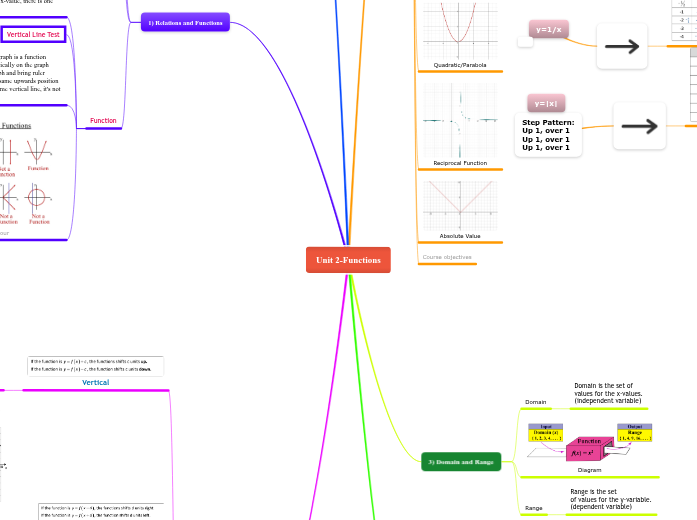Unit 2-Functions
4) Parent Functions
What is it?
A parent function is the simplest function
in a family of functions
The Different Types:
-Linear
-Square Root
-Quadratic
-Reciprocal
-Absolute Value
Linear Function
Square Root Function
Quadratic/Parabola
Reciprocal Function
Absolute Value
Course objectives
3) Domain and Range
Domain
Domain is the set of
values for the x-values.
(independent variable)
Diagram
Range
Range is the set
of values for the y-variable.
(dependent variable)
5) The Inverse of a Function
& its Properties
Inverse Function is when
two functions are
the reverse of each other
or the opposite of one
another.
How to find inverse?
Switch x and y
-If set of points are given
-Switch x and y values
-if equation is given
-same rule applies, switch
x and y
Inverse: Linear
Given this equation find the inverse
Equation
Using the vertical line method,
the inverse is proven to be a function
Quadratic Function:
inverse does not pass vertical
line test, therefore it's not a
function
2) Function Notation
and evaluating functions
The label 'fx' is used
to represent the y-value/dependent
variable of a function. It is the
output of a function.
Determining the
value of a function
In both a) and b), you must plug in the numbers accordingly. In a), the '+5' goes after the function, however
for b) the '2' goes in front of the function.
Placing the given numbers in the incorrect
spot can change the equation.
1) Relations and Functions
Set Notation
This is a set notation, the domain
and range are also stated.
A set is a collection of values/items
which are listed inside curly brackets.
Relation
A relation is a set of ordered pairs
ex, (x,y)
Function
A function is a set of inputs, in relation
to a set of outputs. Each input has its own
output. For every x-value, there is one
y-value.
Vertical Line Test
-used to find out whether graph is a function
-Using a ruler, place it vertically on the graph
-Start from one end of graph and bring ruler
across it, keeping it in the same upwards position
-If two points shown on same vertical line, it's not
a function
Day, Date,Hour
6) Translations of
Parent Functions
Vertical
-only the y changes, x stays the same
Horizontal
In this graph, only x changes, but y remains the same
1) List all the transformations (use summary of transformations if needed)
2) Do the mapping notation (horizontal is opposite)
3) Write down table of x and y values for the parent function
and then write a new table and plug in the x and y values into
the map notation x and y.
4) use those points to map your translated equation
Summary of Transformations
Writing the Equation
example. (absolute value function)
Step Pattern:
Up 1, over 1
Up 1, over 1
Up 1, over 1
Step Pattern:
Up 1, over 1
Up 1, over 3
Up 1, over 5
Subtopic
